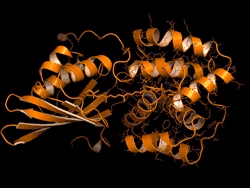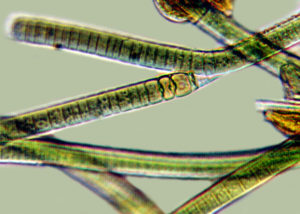
Orange Carotenoid Protein (OCP) shifting from light-absorbing orange state to energy-quenching red state. (Credit: Kerfeld lab)
Research led by Cheryl Kerfeld, with members of her group in Berkeley Lab Biosciences’ Molecular Biophysics and Integrated Bioimaging (MBIB) Division, as well as her MSU-DOE Plant Research group at Michigan State University, has identified and characterized a new, functionally distinct member of the Orange Carotenoid Protein (OCP) family. The OCP complex enables chromatically acclimating blue-green algae to avoid cellular damage and growth inhibition in conditions of high light or nutrient stress.
In a recent bioinformatic analysis of all available cyanobacterial genomes, Kerfeld’s group found that many of these ecophysiologically diverse organisms encode more than one copy of the full-length OCP. The focus of the current study, published in Nature Plants, was the filamentous blue-green algae Tolypothrix, which encodes two OCPs.
One copy was determined to be functionally equivalent to the well-characterized OCP of Synechocystis cyanobacteria, dubbed OCP1. But the second, OCP2, was distinct in several key aspects. The researchers hypothesize that OCP2, and another bioinformatically identified protein, OCPx, reflect intermediate stages in the evolution of photoprotection in cyanobacteria.
Matthew Melnicki, Markus Sutter, and Fei Cai of MBIB contributed to the study, which also utilized the Advanced Light Source (ALS), a DOE Office of Science User Facility, to measure X-ray diffraction and the PHENIX software suite to solve molecular structures.




